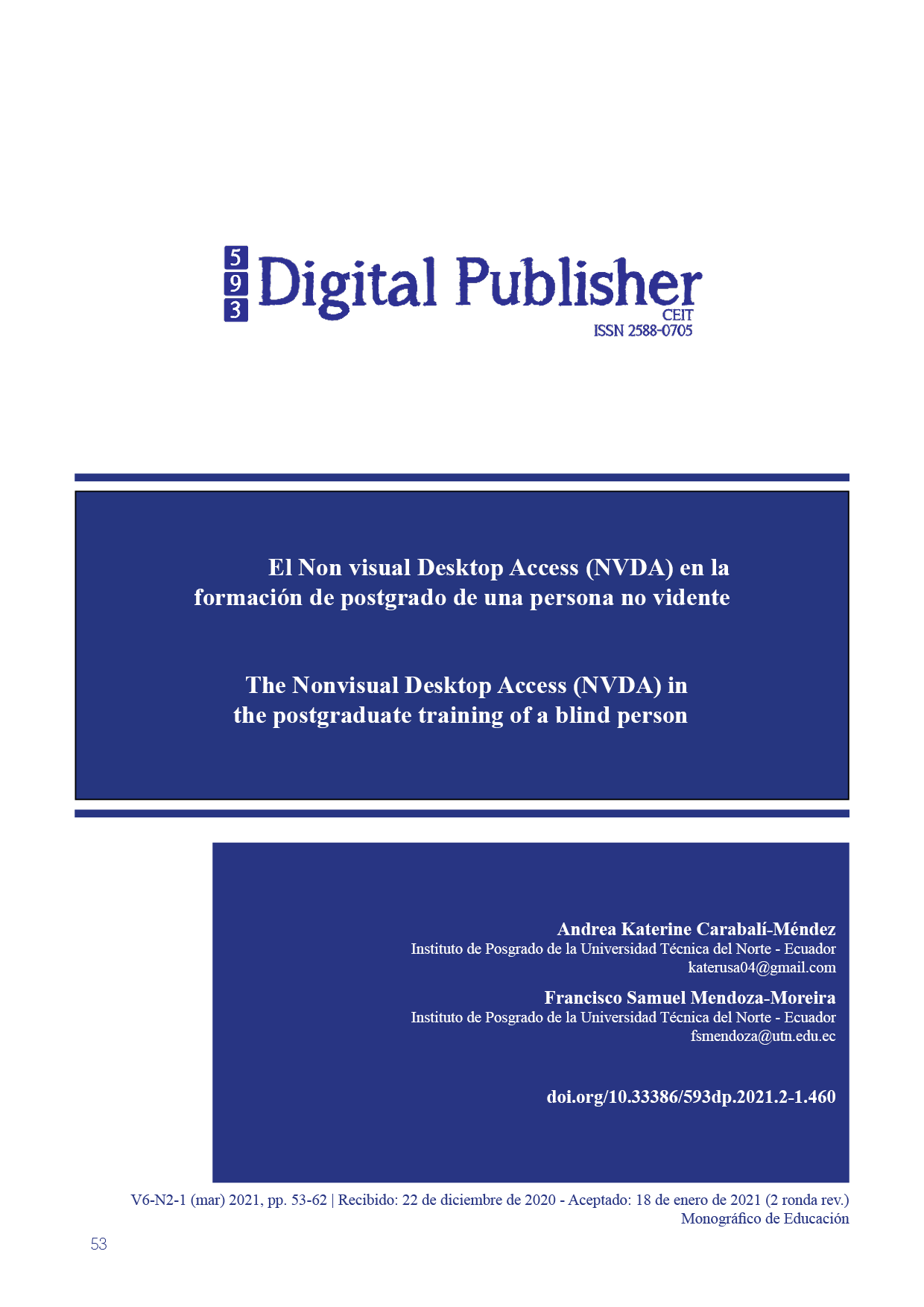El The Nonvisual Desktop Access (NVDA) in the postgraduate training of a blind person Autobiography
Main Article Content
Abstract
INTRODUCTION: The limitations that are presented to a person with visual impairment have limited their professional training due to the lack of significant and very significant access curricular adaptations that facilitate their permanence even in postgraduate courses. METHOD: This work is the result of a biographical-narrative investigation that collects the experience of a professional with visual impairment acquired during her postgraduate training with a qualitative approach oriented to the deconstruction of experience. RESULTS: The work describes the usefulness of the Non-Visual Desktop Access (NVDA) screen reader as an adaptation of access to postgraduate processes in Inclusive Attention to Special Educational Needs. DISCUSSION: The NVDA screen reader is not only an access device to the educational process, it also contributes to the daily life of the subject in his family, personal and educational environment, allowing the subject to achieve autonomy and functionality as a subject of rights and independent individual.
Downloads
Article Details

This work is licensed under a Creative Commons Attribution-NonCommercial-ShareAlike 4.0 International License.
1. Derechos de autor
Las obras que se publican en 593 Digital Publisher CEIT están sujetas a los siguientes términos:
1.1. 593 Digital Publisher CEIT, conserva los derechos patrimoniales (copyright) de las obras publicadas, favorece y permite la reutilización de las mismas bajo la licencia Licencia Creative Commons 4.0 de Reconocimiento-NoComercial-CompartirIgual 4.0, por lo cual se pueden copiar, usar, difundir, transmitir y exponer públicamente, siempre que:
1.1.a. Se cite la autoría y fuente original de su publicación (revista, editorial, URL).
1.1.b. No se usen para fines comerciales u onerosos.
1.1.c. Se mencione la existencia y especificaciones de esta licencia de uso.
References
Alfonso, I. (2003). La educación a distancia. ACIMED, 12-19. Obtenido de <http://scielo.sld.cu/scielo.php?script=sci_arttext&pid=S1024-94352003000100002&lng=es&nrm=iso>
Antón, Á. (2011). Discapacidad visual e incidencia en la autonomía. En Organización Nacional de Ciegos Españoles, Discapacidad visual y autonomía personal (págs. 77-110). ONCE - España.
Aquino, S., García, V., & Izquierdo, J. (2012). La inclusión educativa de ciegos y baja visión en el nivel superior. Un estudio de caso. Sinéctica, 1-21. Obtenido de http://www.scielo.org.mx/scielo.php?script=sci_arttext&pid=S1665-109X2012000200007
Arias, M. E. (2010). Relaciones interpersonales entre niños con discapacidad visual y sus compañeros videntes en el contexto educativo regular. Universidad de Cuenca.
Baquero, R. (octubre de 2020). Instituto para la investigación educativa y desarrollo pedagógico. Obtenido de Notas sobre el aprendizaje escolar: http://www.idep.edu.co/?q=content/notas-sobre-el-aprendizaje-escolar-%E2%80%93-ricardo-baquero
Consejo Nacional de Fomento Educativo [CONAFE]. (2010). Discapacidad visual. Guía didáctica para la inclusión en educación inicial y básica. CONAFE.
Corredor-Ponce, Z. (2016). Las adecuaciones curriculares como elemento clave para asegurar una educación inclusiva. Educ@ción en Contexto, 56-78. Obtenido de https://dialnet.unirioja.es/descarga/articulo/6296699.pdf
Curran, M., & Turner, R. (2020). Non Visual Desktop Access. Obtenido de 2020 program and schedule: https://www.nvdacon.org/
Denzin, N., & Lincoln, Y. (2015). Manual de investigación cualitativa Vol 4: Métodos de recolección y análisis de datos. Editorial Gedisa.
García, M. (2015). Discapacidad. Especial referencia a la educación. Revista de Investigaciones Políticas y Sociológicas, 193-208. doi:https://doi.org/10.15304/rips.14.1.2440
Goodson, I. (2004). Historias de vida del profesorado. Ediciones Octaedro.
Guncay, J., & Durán, J. (2005). Discapacidad visual en el entorno familiar, una visión desde el Trabajo Social. Universidad de Cuenca.
Gutiérrez, V., & Carrizosa, M. (2016). Genética del glaucoma primario de ángulo abierto. Ciencia y tecnología de la Salud Visual - ocular, 107-116. doi:https://doi.org/10.19052/sv.3634
Hernández, R., Fernández, C., & Baptista, P. (2014). Metodología de la investigación. McGraw Hill.
Nuñez, M. Á. (1999). La deficiencia visual. III Congreso “La Atención a la Diversidad en el Sistema Educativo” (págs. 1-15). Universidad de Salamanca.
Organización Mundial para la Salud. (8 de octubre de 2019). Organización Mundial para la Salud. Obtenido de Ceguera y discapacidad visual: https://www.who.int/es/news/item/08-10-2019-who-launches-first-world-report-on-vision
Roselli, N. (2016). El aprendizaje colaborativo: Bases teóricas y estrategias aplicables en la enseñanza universitaria. Propósitos y Representaciones, 219-280. doi:http://dx.doi.org/10.20511/pyr2016.v4n1.90
Vargas, A. L., & Villalobos, G. (2018). El uso de plataformas virtuales y su impacto en el proceso de aprendizaje en las asignaturas de las carreras de Criminología y Ciencias Policiales, de la Universidad Estatal a Distancia de Costa Rica. Educare, 20-39. doi:http://dx.doi.org/10.15359/ree.22-1.2
Zappalá, D., Köppel, A., & Suchodolski , M. (2011). Inclusión de tic en escuelas para alumnos con discapacidad visual. Ministerio de Educación de la Nación.



